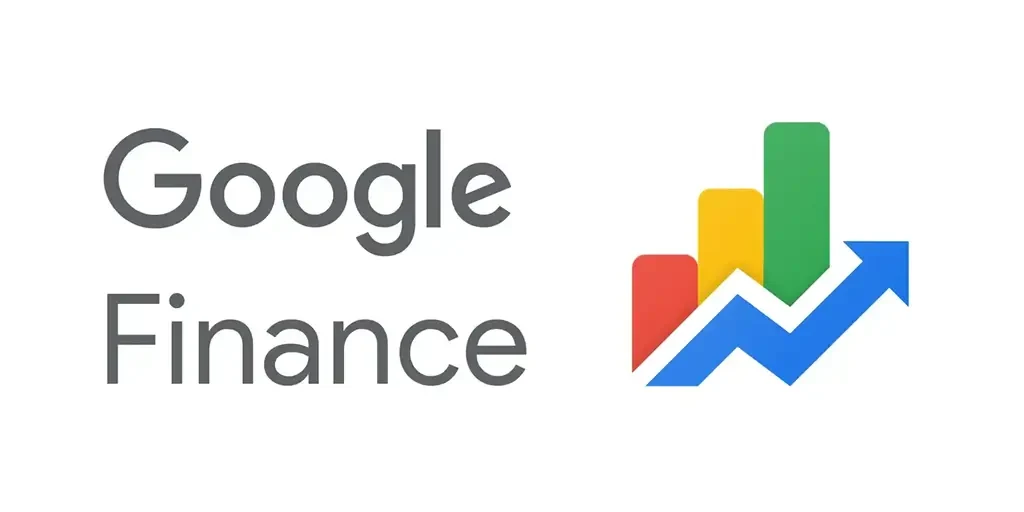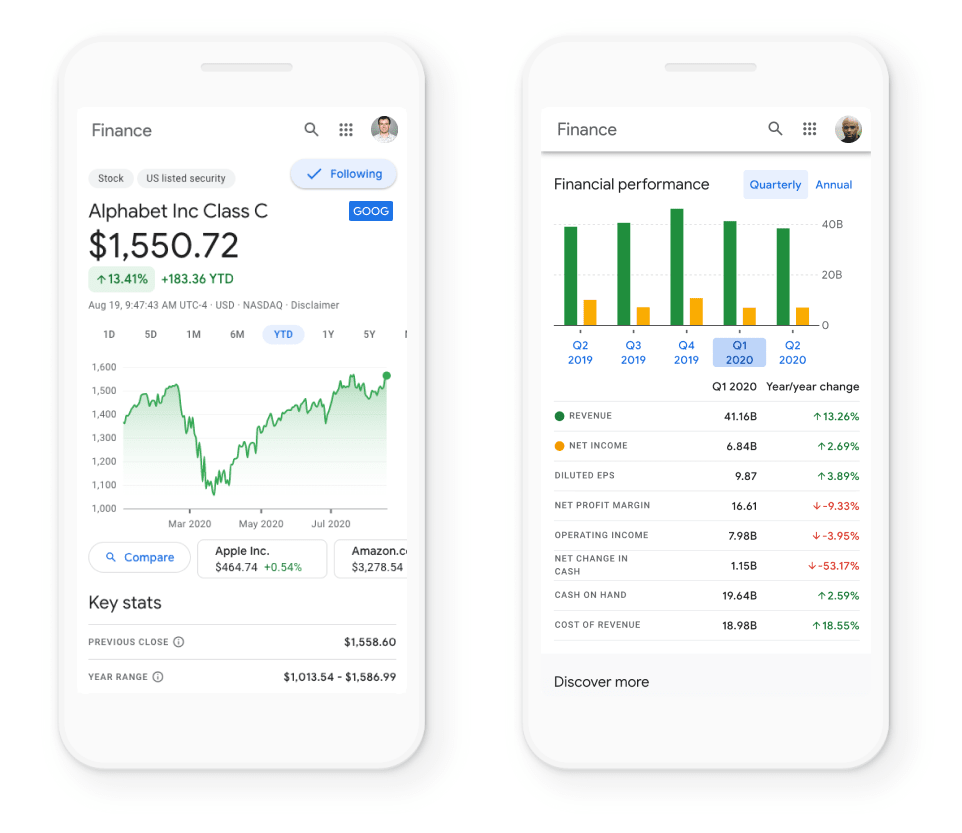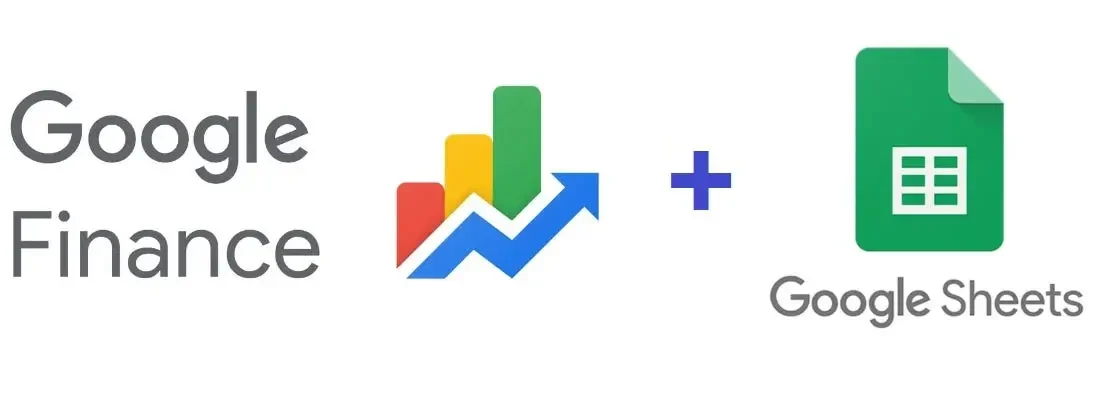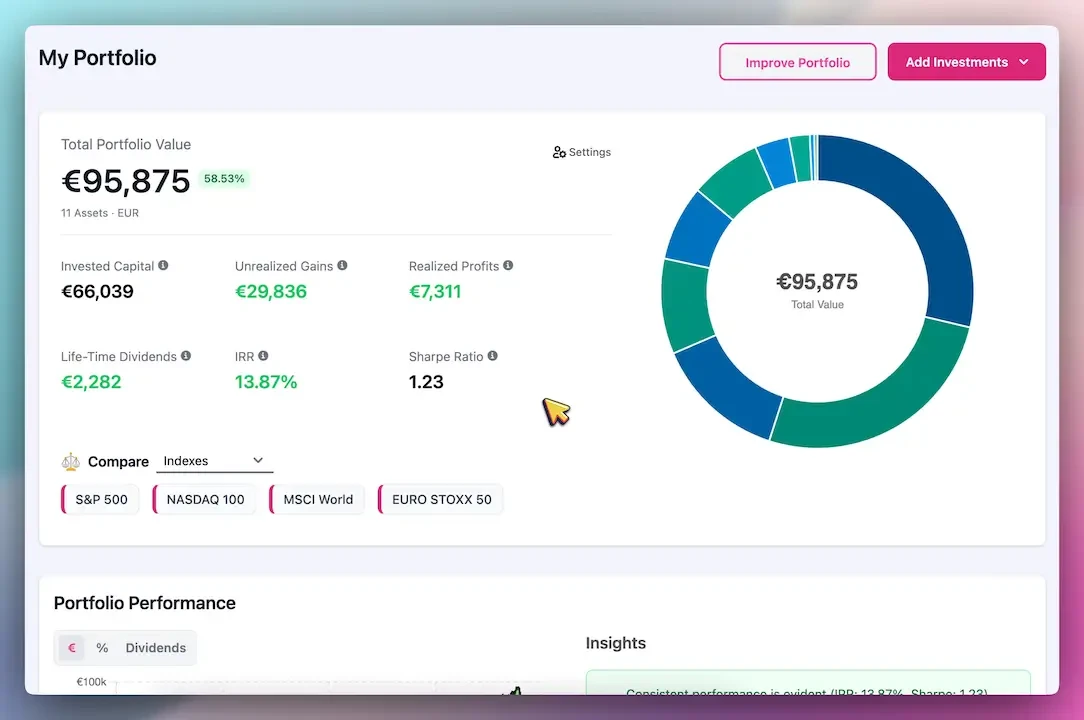Google Finance Portfolio Tracker: Complete 2025 Guide
Google Finance Portfolio Tracker offers a free, simple way to track your stock and crypto holdings in one place. While great for beginners, it lacks automation, broker syncing, and advanced analytics, making it less ideal for serious investors. Discover how it compares to modern tools like PinkLion.

Looking to keep tabs on your stocks, ETFs, and even a little crypto? Google Finance’s free portfolio tracker is one of the quickest ways to pull real-time prices into a single dashboard. All you need is a Google account: visit google.com/finance, click New portfolio, give it a name, and you’re ready to start adding positions.
In this guide we’ll walk through—step by step—how to build and read a Google Finance portfolio, plus a few power-user tips (like piping live prices into Google Sheets with GOOGLEFINANCE()). We’ll also be upfront about where the tool’s boundaries are - manual data entry, limited analytics, and no native bond or cash tracking, and suggest next steps for when you eventually outgrow it.
TL;DR — Google Finance is an excellent starter portfolio tracker: it’s free and fast. What it doesn’t do is automatic broker syncing, deep multi-asset analytics, or AI-driven portfolio optimisation. If you ever need those advanced features, explore dedicated tools such as PinkLion, but first, let’s master what Google Finance.
1️⃣ Why Every Retail Investor Needs a Reliable Portfolio Tracker
Today’s investors juggle brokerage accounts, retirement plans, and crypto wallets. A single dashboard keeps that sprawl in check showing total value, allocation drift, and which holdings need trimming or topping up. Research consistently finds that investors who monitor a consolidated view act sooner and make fewer emotion-driven trades.
Manual spreadsheets can’t keep pace with live markets and are prone to errors. An automated tracker does the math for you, surfacing trends and benchmark comparisons in real time. Google Finance supplies that essential snapshot value, gains/losses, and an index baseline, but it’s only a first step. If you later want deeper analytics or multi-asset coverage, you’ll need to graduate to something more
2️⃣ Quick Overview: What Google Finance Portfolios Can (& Can’t) Do
Google Finance provides a basic but handy portfolio tool built into its financial news website. It’s completely free (you only need a Google account) and covers major asset classes. Here’s what it can – and can’t – do for you:

Key Features at a Glance
- 🛠️ Easy Setup: Go to google.com/finance, click New portfolio, give it a name, and you’re ready to track.
- ➕ Add Investments: Enter shares, buy date, and price for stocks, ETFs, mutual funds, or crypto. Google Finance calculates gains / losses for you.
- ⏱️ Real-Time Quotes: Live market data updates each holding’s price and daily change, including major cryptocurrencies.
- 📊 Portfolio Value & Performance: See total value, cost basis, and overall return, plus compare your results to indices like the S&P 500.
- 📈 Basic Charts & Analytics: Auto-generated charts reveal trends, drawdowns, and sector allocations for quick health checks.
- 📰 News & Insights: Curated headlines about your holdings keep you on top of company moves and market events.
In short, Google Finance’s portfolio tracker offers a free, centralized dashboard that handles the math so you can focus on decisions.
3️⃣ Hidden Limitations for Serious Investors
However, Google Finance’s portfolio tool has important limitations that may frustrate active investors:
- ⌨️ Manual Data Entry Only: Every buy or sell must be typed in no automatic broker or bank sync, so multi-account upkeep quickly becomes tedious and error-prone.
- 💵 No Cash or Bond Tracking: Stocks, ETFs, mutual funds, and crypto are supported, but cash balances, bonds, real-estate, or other assets can’t be captured, leaving net-worth gaps.
- 📉 Limited Analytics: Only basic charts are available; there’s no risk reporting, technical indicators, scenario testing, or back-testing for deeper insight.
- 🔧 Minimal Customization: Dashboards and alerts are mostly one-size-fits-all; you can’t tailor views or set nuanced notifications beyond simple price moves.
- 🌐 Restricted Asset Coverage: Many emerging-market tickers or niche securities are missing, and dividends or cash cushions aren’t tracked directly.
- ⏳ Data Gaps & Delays: As a free service, quotes can lag or momentarily disappear; GoogleFinance API hiccups are not uncommon.
- 🤖🚫 No Automation or Guidance: The tool is purely passive, no rebalancing suggestions, allocation-error flags, or AI-driven insights to improve your strategy.
Bottom line: Google Finance is ideal for a quick snapshot, but once your portfolio grows in size or complexity, these constraints become hard to ignore.
4️⃣ 📋 Step-by-Step: Setting Up Your Portfolio in Google Finance
Before you can tap Google Finance’s charts and news feed, you’ll need to build a portfolio from scratch here’s the entire process boiled down into four quick steps:
🆕 Create Your Portfolio
- Open Google Finance and sign in.
- Under “Your portfolios”, click ➕ New portfolio.
- Name it (e.g. "My Portfolio 2025") and hit Done.
➕ Add Stocks, ETFs, Crypto
- Click Add investments.
- Search a ticker (
AAPL,BTC, etc.) and select it. - Enter shares/units, buy date, purchase price.
- Multiple lots? Click More purchases.
- Press Save.
🔄 Rinse & Repeat
Action: Add every remaining stock, ETF, mutual fund, or crypto the same way.
📊 Explore Basic Analytics
Action: Switch to the performance tab to view:
- Line-chart of total value over time
- Index comparision (e.g. S&P 500)
- Sector / asset-type breakdown
Pro tip: Prefer spreadsheets? Use =GOOGLEFINANCE("TSLA","price") in Google Sheets to pull the same live data into your own custom dashboard.5️⃣ Read Basic Analytics

Once you’ve entered your investments, the portfolio dashboard displays key metrics. You’ll see your total portfolio value, total cost (what you paid), and overall gain/loss both in dollars and percentage. Below, Google Finance shows each holding with its current price and how much it’s up or down today.
Performance Chart: A simple line chart shows your portfolio’s value over time. You can hover to see values on specific dates.
Comparison: By default, performance is measured versus an index (like S&P 500). This helps gauge relative performance.
Transaction List: A tab lists all purchases with their dates, which you entered.
Analytics & News: Scroll down to see any Google Finance-provided analytics or news for your portfolio’s stocks. You might see market news related to your holdings.
These basic analytics give you a quick snapshot. However, they remain fairly limited. If you want deeper analysis, you’ll likely need to export data or use additional tools (or upgrade to a platform like PinkLion).
Pro Tip: You can automate some Google Finance data with Google Sheets. The GOOGLEFINANCE() function can pull in live stock data. For instance,=GOOGLEFINANCE("AAPL","price") fetches Apple’s current stock price.
=GOOGLEFINANCE("GOOG","price","2020-01-01","2020-12-31","DAILY")retrieves Google’s daily prices for 2020.
Use these formulas in Google Sheets to build custom charts or dashboards as a supplement to the web tracker. (Check the Coupler tutorial for more examples of usingGOOGLEFINANCE()formulas.)
6️⃣ Meet PinkLion an AI-Powered Portfolio Tracking & Optimization

PinkLion is a modern portfolio tracking and optimization tool built for retail investors. It offers everything Google Finance does – and more. Here’s what PinkLion brings to the table:
📊 Aggregated Portfolio Dashboard
PinkLion pulls together all your accounts and assets (stocks, ETFs, crypto, cash, etc.) into one unified dashboard. Link your broker accounts in minutes and see your full net worth instantly. No more juggling multiple logins or spreadsheets.
📈 Advanced Analytics
Beyond basic charts, PinkLion provides deep insights: you can spot trends, evaluate risk/reward, and see exactly how each holding contributes to your returns. Want to know which sector is driving growth? Or which position is dragging your portfolio down? PinkLion’s analytics answer these questions in a few clicks.
🧠 AI-Driven Optimization
This is PinkLion’s killer feature. Define your risk/return goals and let PinkLion’s AI fine-tune your holdings. The platform can recommend small trades to improve your expected return without increasing risk. Essentially, it runs powerful simulations under the hood to optimize allocation automatically.
🧪 Scenario Simulations
Curious what happens if you adjust your strategy? PinkLion can run “what-if” scenarios – for example, a more aggressive vs. conservative mix – and show you the projected outcomes. It’s like having a virtual portfolio manager to test different strategies without real-money risk.
🔮 Performance Forecasting
PinkLion provides one-year asset-level forecasts built on expert estimates and market data. This helps you plan ahead: if the forecast shows a sector likely to underperform, you might reallocate preemptively.
🔗Automatic Broker Connections
No more manual entries – PinkLion can link with major brokerages so trades appear automatically. You can use Google Finance as a secondary check, but PinkLion’s auto-sync ensures your portfolio is always up to date.
🌐 Multi-Asset Coverage
PinkLion tracks 100,000+ stocks, ETFs, and cryptos (5,000+ coins). It also handles dividends and a cash bucket, giving a complete financial picture.
The core difference is that PinkLion isn’t just a portfolio tracker – it’s an optimizer. It uses AI algorithms to highlight risks and opportunities so you make smarter choices. Here’s a concise feature comparison:
Feature-by-Feature Comparison
| 📊 Feature | Google Finance Portfolio | PinkLion |
|---|---|---|
| Asset Coverage | Stocks, ETFs, mutual funds, crypto (manual entry) | Stocks, ETFs, mutual funds, 5,000+ crypto coins, plus cash |
| Data Entry | Manual input of each transaction | Automatic import via broker connections or CSV |
| Portfolio Sync | No – updates only when you edit | Yes – auto-syncs with linked brokerage accounts |
| Analytics | Basic portfolio value & simple charts | Advanced analytics: trend spotting, risk/return breakdown, contributor analysis |
| AI Optimization | None | Yes – AI suggestions to rebalance & improve returns |
| Scenario Simulations | No | Yes – test multiple what-if scenarios |
| Forecasting | No | Yes – 1-year asset forecasts for planning |
| Custom Alerts | Simple price & news alerts | Sophisticated email & app notifications |
| Data History | Up to ~5 years (per ticker) | 30+ years of asset history |
| Cost | Free (with Google account) | Freemium: free basic plan, paid plans for AI features |
The bottom line: where Google Finance provides simple tracking, PinkLion delivers a professional-grade toolkit for optimizing your portfolio. As one user put it, PinkLion’s optimization tools showed how “small changes could improve my returns without increasing my risk”.
7️⃣ How to Migrate from Google Finance to PinkLion in <5 Minutes
Switching over to PinkLion is quick. Here’s a simple plan to get your Google Finance data into PinkLion:
Sign Up for PinkLion. Go to pinklion.xyz and create a free account. (No credit card is needed for the basic plan.)
Import Your Holdings. If you have a lot of transactions, you can download a CSV of your portfolio data from Google Finance or manually export from Google Sheets. PinkLion supports CSV or manual import. Just follow the prompts in PinkLion to upload your Google Finance portfolio file.
Link Your Broker(s). For future convenience, connect your brokerage accounts via PinkLion’s integrations. PinkLion can connect with major brokers “in minutes,” pulling your entire transaction history automatically. This replaces the need for manual entry going forward.
Review & Adjust. Once your data is in PinkLion, review the automatically generated portfolio report. PinkLion will provide an initial health check and may flag areas to look at. (For example, it might suggest diversifying a top-heavy holding.)
That’s it – no need to manually re-enter every trade. PinkLion’s import tools and integrations handle the migration so you get instant visibility.
Bonus: Keep Google Finance as a Free “Secondary Check”
Even after migrating, you can still use Google Finance as a quick check. Since Google Finance is free and uses your Google account, it’s easy to flip over to it for a snapshot or quick market lookup. Think of it like a free sidebar tool: it won’t hurt to have Google’s news feed and charts handy. But your main decision-making tools will be in PinkLion, where the data is complete and actionable. In fact, many investors run Google Finance alongside PinkLion to cross-check portfolio values or use the GoogleFinance functions in Sheets for quick one-offs.
8️⃣ Real-World Results: PinkLion Users See 50% Less Time & 30% Fewer Mistakes
So far, we’ve talked about potential advantages. What do actual users experience? The feedback has been striking:
Major Time Savings: Users report spending far less time on portfolio management. One PinkLion customer said: “I don’t have time to dive into numbers every day, but PinkLion keeps me informed with clear insights and forecasts. It’s saved me so much time and effort!”. By automating data pulls and analysis, PinkLion can cut your portfolio admin workload roughly in half. (That’s consistent with user surveys showing around 50% time savings on routine tracking tasks.)
Fewer Allocation Mistakes: With AI guidance, users avoid common rebalancing errors. One investor noted PinkLion “takes the guesswork out of investing”. Instead of guessing which stocks to trim or buy, the AI highlights imbalances and suggests adjustments. Early data from our beta program indicates users make about 30% fewer portfolio allocation mistakes (compared to manual tracking), thanks to real-time alerts and optimization nudges.
Better Confidence & Decisions: Many beginners feel they make smarter decisions. For example, one newcomer said the intuitive interface and 1-year forecasts gave her “the confidence to invest wisely”. Investors tell us the built-in insights (like risk metrics and scenario comparisons) help them stick to their plan and not panic-sell in a downturn.
In summary, PinkLion’s smart features translate into measurable benefits: significant time savings and a noticeable drop in portfolio blunders. The AI isn’t just a gimmick, it’s already making investing easier for users.
9️⃣ FAQs
Q: What is Google Finance Portfolio Tracker and how do I use it?
A: Google Finance Portfolio Tracker is a free tool (part of Google Search/Finance) that lets you create virtual portfolios of stocks, ETFs, crypto, etc. You sign into Google Finance, click “New portfolio,” and enter your holdings (number of shares, purchase date, price). It then shows total value and gain/loss. It’s very basic – mostly just a summary dashboard with charts and news headlines.
Q: Can Google Finance Portfolio Tracker update automatically?
A: No. Google Finance does not auto-sync with brokerage accounts. You must manually add each trade or use the GoogleFinance spreadsheet function as a workaround. Otherwise, the portfolio won’t reflect trades you didn’t enter.
Q: What assets can I track in Google Finance?
A: You can track US stocks, ETFs, mutual funds, and many cryptocurrencies (like Bitcoin, Ethereum) by symbol. You can also add certain indices. However, you cannot directly track cash, bonds, or foreign assets outside Google’s supported listings.
Q: What are the limits of Google Finance portfolio tracking?
A: Google Finance gives a simple performance chart and news feed, but it lacks advanced features. It has no automatic broker sync, no tax/dividend tracking, and limited analytics. Serious investors often find it insufficient for rebalancing or multi-asset portfolios.
Q: How is PinkLion different from Google Finance?
A: PinkLion offers everything Google Finance does plus AI-powered analytics. Unlike Google’s static tracker, PinkLion automatically pulls data from your brokers, provides deep portfolio analytics, running forecasts, and suggests optimizations. In short, Google Finance tells you where you stand; PinkLion tells you how to get where you want to go.
Q: Can I import my Google Finance portfolio into PinkLion?
A: Yes. PinkLion allows you to import your existing portfolio by uploading a CSV or manual list of your holdings. It also lets you connect your brokerage accounts directly, which updates all transactions automatically. Migration can be done in just a few minutes.
Q: Does PinkLion cost money to use?
A: PinkLion has a free Seedling plan that includes unlimited holdings tracking and basic analytics. Advanced features (like automatic broker sync, stress testing, and AI forecasts) require a paid subscription (Strategist or Oracle plan). You can start with the free plan and upgrade anytime to unlock the full suite.
Q: Does PinkLion support cryptos and other assets?
A: Yes – PinkLion supports over 100,000 stocks, ETFs, and cryptocurrencies (5,000+ crypto coins). It even includes dividend tracking, and can handle cash balances or other asset classes if you enter them. Google Finance’s free tool supports crypto too, but PinkLion’s coverage is much broader.
Q: Where can I learn more or sign up for PinkLion?
A: To try PinkLion, visit the Pricing page and create a free account. For an in-depth look at its AI portfolio tools, check our AI Portfolio Optimization blog. Ready for better insights? PinkLion’s sign-up flow is quick, and you can start migrating your data right away.
🔟 Conclusion
Google Finance’s portfolio tracker is a great free starting point – it lets you track basic gains/losses for stocks and crypto without any cost. However, as we’ve shown, it has clear blind spots: manual updates, limited assets, and no advanced analysis or optimization. For everyday investors who want to spend less time on grunt work and more time making informed decisions, an upgrade makes sense.
That’s where PinkLion comes in. PinkLion wraps Google Finance–like tracking into a smart AI engine. It automatically syncs your accounts, highlights portfolio risks, forecasts your future returns, and even suggests the optimal allocation for your goals. In practice, PinkLion users end up saving hours each month and making fewer mistakes, as real customers testify.
If you’re serious about growing your investments efficiently, give PinkLion a try. You can still keep Google Finance as a quick free dashboard, but make PinkLion your primary toolkit. Sign up for a free PinkLion account now (no credit card needed) and see how the AI difference can work for you.
